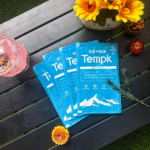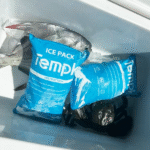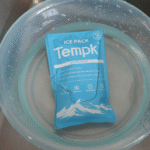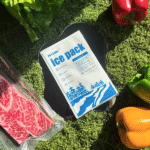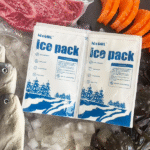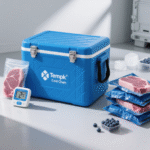In 2025, maintaining precise temperature control during shipment is more crucial than ever, especially for the biotech, pharmaceutical, and perishable food industries. Biotech dry ice pack sheets have become a game-changer in ensuring product integrity, reducing costs, and improving compliance with regulatory guidelines. This article delves into the science behind these advanced cooling solutions, how they enhance cold chain logistics, and the latest trends shaping their use in 2025.
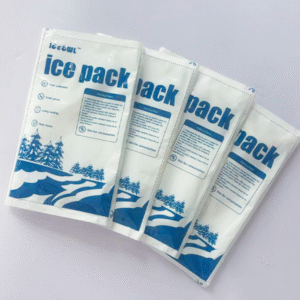
What Are Biotech Dry Ice Pack Sheets?
Biotech dry ice pack sheets are specially engineered cooling solutions made from compressed solid carbon dioxide (CO₂). These sheets are incredibly effective for maintaining ultra-low temperatures during long-distance shipping, with a cooling capacity reaching up to -78.5°C (-109.3°F). When activated, the dry ice sublimates, turning from a solid into a gas, which absorbs heat and maintains a consistent, controlled cold environment.
The sheets are typically thin, flexible, and easy to handle, making them an ideal solution for shipping sensitive products such as biotechnology samples, vaccines, and pharmaceutical products. Their reusability and cost-efficiency are key advantages over traditional gel packs and ice packs, which provide limited cold retention and may leave behind water that could potentially contaminate the contents.
How Do Biotech Dry Ice Pack Sheets Work?
To activate the dry ice pack sheets, they are soaked in water and then frozen for several hours. Once frozen, the sheets maintain their flexibility and can be shaped around various types of products. Unlike conventional ice or gel packs, these dry ice sheets don’t leave any residual water behind, making them ideal for sensitive biotech materials, which could be compromised by moisture.
| Cooling Method | Temperature Control | Duration | Effectiveness |
|---|---|---|---|
| Biotech Dry Ice Sheets | -109.3°F (-78.5°C) | 48–72 hours | Highly effective |
| Gel Packs | 32°F (0°C) | Varies | Moderate |
| Ice Packs | 32°F (0°C) | Varies | Low to moderate |
Why Are Biotech Dry Ice Pack Sheets Vital for Long-Distance Shipping?
Long-distance shipments—often lasting several days or even weeks—pose a significant challenge to maintaining temperature stability. Biotech dry ice pack sheets are designed to withstand extended periods of sublimation, offering a reliable solution for transporting temperature-sensitive goods over long distances.
They ensure that shipments stay within their required temperature ranges, preventing spoilage and degradation. For example, cell cultures, enzymes, and vaccines—all requiring sub-zero temperatures—benefit greatly from the consistency provided by dry ice sheets, which can maintain a stable cold chain even on global routes.
Sustainable Shipping Practices with Biotech Dry Ice Pack Sheets
As environmental concerns take center stage, sustainability in shipping logistics is becoming increasingly important. Dry ice production has evolved to reduce its carbon footprint, with more sustainable methods being integrated into the creation of dry ice pack sheets. Companies are also incorporating IoT technology for real-time monitoring, allowing for immediate adjustments to temperature settings during transit, ensuring the highest level of compliance with regulatory standards.
Trends in Biotech Dry Ice Pack Sheets for 2025
In 2025, several innovations are poised to enhance the use of biotech dry ice pack sheets in cold chain logistics:
-
Sustainability Advancements: New methods in dry ice production are making the process more energy-efficient and eco-friendly, reducing the environmental impact associated with its production.
-
IoT Integration: Real-time temperature monitoring and smart sensors are embedded in shipping solutions, including dry ice sheets, to track temperature variations and optimize performance, reducing risks associated with temperature excursions.
-
Hybrid Cooling Systems: Many businesses are combining dry ice sheets with phase-change materials (PCMs) to create hybrid solutions. These hybrid systems allow for ultra-cold temperatures initially provided by dry ice, followed by stable conditions maintained by PCMs, making them ideal for varied product types and temperature ranges.
Advantages of Biotech Dry Ice Pack Sheets Over Gel Packs and Ice Packs
-
Colder Temperature: Biotech dry ice sheets provide much lower temperatures than gel or ice packs, making them essential for biotech and pharmaceutical products.
-
Extended Longevity: Dry ice lasts significantly longer than conventional cooling methods, allowing for more extended transport periods without compromising product quality.
-
No Residual Water: Dry ice sublimates into gas, leaving no water behind, preventing the risk of moisture damage—a common issue with gel or ice packs.
Regulatory Compliance in Cold Chain Logistics
Biotech dry ice pack sheets not only support temperature stability but also ensure regulatory compliance. Strict guidelines in the shipping of pharmaceuticals, biotechnology products, and food require that temperatures remain consistent throughout the entire transport process. Failure to maintain the correct temperature can lead to compliance violations, loss of product efficacy, and costly returns.
Biotech dry ice sheets ensure that shipments meet GxP (Good Manufacturing Practice) and FDA regulations, making them a vital component of a reliable cold chain logistics solution.
Safety Considerations for Handling Dry Ice
Handling dry ice requires careful attention. Always ensure that the packaging allows for the safe sublimation of CO₂ gas, which can build up pressure if trapped. Personal protective equipment (PPE) such as gloves and goggles is essential to avoid frostbite or injury while handling dry ice.
FAQs About Biotech Dry Ice Pack Sheets
Q1: How long can biotech dry ice pack sheets maintain cold temperatures?
Dry ice pack sheets typically maintain ultra-low temperatures for 48–72 hours, depending on the environmental conditions and the size of the pack.
Q2: Can biotech dry ice pack sheets be reused?
Yes, these sheets are reusable after rehydration and freezing. They can last for several shipments if maintained properly.
Q3: Are biotech dry ice pack sheets safe to handle?
Yes, but safety precautions are necessary. Always handle with gloves and goggles, and ensure proper ventilation to allow CO₂ gas to escape.
Conclusion and Recommendations
Biotech dry ice pack sheets are revolutionizing cold chain logistics by providing reliable, cost-effective, and sustainable solutions for temperature-sensitive products. Their ability to maintain ultra-cold temperatures over extended shipping periods, coupled with their sustainability and reusability, makes them an ideal choice for biotech and pharmaceutical companies.
To stay competitive in 2025, companies should invest in advanced dry ice solutions, including IoT integration, sustainable production methods, and hybrid cooling systems to ensure optimal product integrity, regulatory compliance, and cost efficiency.
Next Steps:
If you’re looking to optimize your cold chain logistics, consider incorporating biotech dry ice pack sheets into your shipping process. Contact a trusted supplier for more information and to find the best cold chain solution tailored to your needs.
About Tempk
At Tempk, we specialize in providing innovative cold chain solutions for the biotech and pharmaceutical industries. Our advanced biotech dry ice pack sheets ensure that your temperature-sensitive products arrive fresh, safe, and compliant with all regulatory standards.
Contact us today to learn how we can help you enhance your cold chain logistics.
















